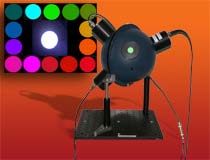This topic covers issues related to energy generation, conversion, transportation and consumption and how the industry is addressing the challenge of energy efficiency in general.
innovations-report provides in-depth and informative reports and articles on subjects ranging from wind energy, fuel cell technology, solar energy, geothermal energy, petroleum, gas, nuclear engineering, alternative energy and energy efficiency to fusion, hydrogen and superconductor technologies.

If you need bright blue light at a very specific wavelength, the National Institute of Standards and Technology (NIST) can make it—and fast.
In the world of color, this is no small accomplishment. NIST’s traditional light sources, such as incandescent lamps, are thermal. A blue thermal source would need to function at such a high temperature that components would melt. Lack of blue light sources introduces uncertainty when calibrating instruments that measure the color of things like

New technology which can create ’natural’ sunlight in offices and homes and save billions on energy bills will soon be in everyday use, scientists will announce this week.
Researchers from the University of Bath will give details of work which will help change fundamentally the way that mobile phones, TVs, cars and buildings use lighting.
The new technology, called Solid State Lighting, will save billions of pounds by reducing the amount of electricity needed to li

Spring’s lush green lawns and hot pink shoes contribute at least in a small way to the world’s total carbon picture, say researchers at the Department of Energy’s Oak Ridge National Laboratory.
Indeed, the latest fashions on Fifth Avenue and fertilizers that help homeowners achieve that “barefoot” lawn have their associated carbon dioxide costs, and ORNL’s Gregg Marland and Tristram West keep up with them. Their task is to track the total carbon produced worldwide and es

Virginia Tech researchers are mixing air and soybean oil to create new polymers to replace petroleum-based materials.
“These natural polymers could be used in biocompatible or biodegradable ways,” says Tim Long of Blacksburg, chemistry professor in the College of Science at Virginia Tech. “We are looking for natural products derived in the United States.”
Ann R. Fornof of Toledo, Ohio, a graduate student in Virginia Tech’s Macromolecular and Science Engineering program, will

Biasing spin statistics
Organic light-emitting diodes (OLEDs) based on pi-conjugated polymers offer significant advantages over other display materials. They are lightweight, flexible, easily tailored, operate on low voltages and can be deposited on large areas using simple techniques such as ink-jet printing or spin-coating.
By combining the electrical properties of metals and semiconductors with the mechanical properties of plastics, these materials are poised to provide a

Duke University researchers exploring ways to build ultrasmall electronic devices out of atom-thick carbon cylinders have incorporated one of these “carbon nanotubes” into a new kind of field effect transistor. The Duke investigators also reported new insights into their previously published technique for growing nanotubes in straight structures as long as half an inch.
Duke assistant chemistry professor Jie Liu will report on these and other nanotube developments during three talks at a na